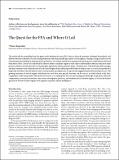The Quest for the FFA and Where It Led
Author(s)
Unknown author
DownloadKanwisher-The Quest for the FFA and Where.pdf (591.0Kb)
PUBLISHER_CC
Publisher with Creative Commons License
Creative Commons Attribution
Terms of use
Metadata
Show full item recordAbstract
This article tells the story behind our first paper on the fusiform face area (FFA): how we chose the question, developed the methods, and followed the data to find the FFA and subsequently many other functionally specialized cortical regions. The paper's impact had less to do with the particular findings in the paper itself and more to do with the method that it promoted and the picture of the human mind and brain that it led to. The use of a functional localizer to define a candidate region in each subject individually enabled us not just to make pictures of brain activation, but also to ask principled, hypothesis-driven questions about a thing in nature. This method enabled stronger and more extensive tests of the function of each cortical region than had been possible before in humans and, as a result, has produced a large body of evidence that the human cortex contains numerous regions that are specifically engaged in particular mental processes. The growing inventory of cortical regions with distinctive and often very specific functions can be seen as an initial sketch of the basic components of the human mind. This sketch also serves as a roadmap into the vast and exciting new landscape of questions about the computations, structural connections, time course, development, plasticity, and evolution of each of these regions, as well as the hardest question of all: how do these regions work together to produce human intelligence?
Date issued
2017-02Department
Massachusetts Institute of Technology. Department of Brain and Cognitive Sciences; McGovern Institute for Brain Research at MITJournal
The Journal of Neuroscience
Publisher
Biomed Central Ltd.
Citation
Kanwisher, Nancy. “The Quest for the FFA and Where It Led.” The Journal of Neuroscience 37, 5 (February 2017): 1056–1061 © 2017 the authors
Version: Final published version
ISSN
0270-6474
1529-2401